Gamemastering Complex Settings
Complex published settings like the post-post apocalypse of Degenesis, the magical world of Glorantha, or the transhumanist future of Eclipse Phase can be intimidating for game masters. But running campaigns in such settings can also be tremendously rewarding. What follows are lessons learned from my own campaigns that should help you set up and run one of your own.
We can come up with all sorts of rationales for why we like the games we like, and there are some objectively-provable differences in aspects like print quality, editing, and the mathematical underpinnings of a game system. But much of it boils down to what we want a game to do for us.
One of the primary reasons I enjoy tabletop RPGs is that they offer the opportunity to dive into imaginary worlds and explore them in ways that just aren’t possible in movies, novels, or even computer RPGs. So games with well-crafted, complex settings get my attention. A truly great published setting mixes history, culture, and belief together to provide fertile ground for adventures. A world that feels lived in and dynamic provides all sorts of competing interests and fodder for conflict and discovery.
Gamemastering these kinds of complex settings can be challenging, especially for worlds that aren’t already known to the players. For example, the Star Wars games from Fantasy Flight Games are attractive to many GMs and players because the Star Wars galaxy is so well known. Even people who aren’t big fans have likely seen a few of the movies and know the broad strokes. It’s easy to introduce new players to the game.
By contrast, the breadth and depth of a complex published setting that is new to everyone at the table can be intimidating to players and GM alike. It takes time and energy to set up and run a campaign in such a world. But if you and your players enjoy immersing yourself in setting, it can be deeply rewarding.
I’ve run many campaigns set in complex published settings such as Glorantha, Eclipse Phase, and Degenesis, and have learned a few lessons the hard way. As with all gamemastering advice, your mileage may vary. So take this as a catalogue of lessons learned from one GM’s experience, rather than a declaration of The One True Way.
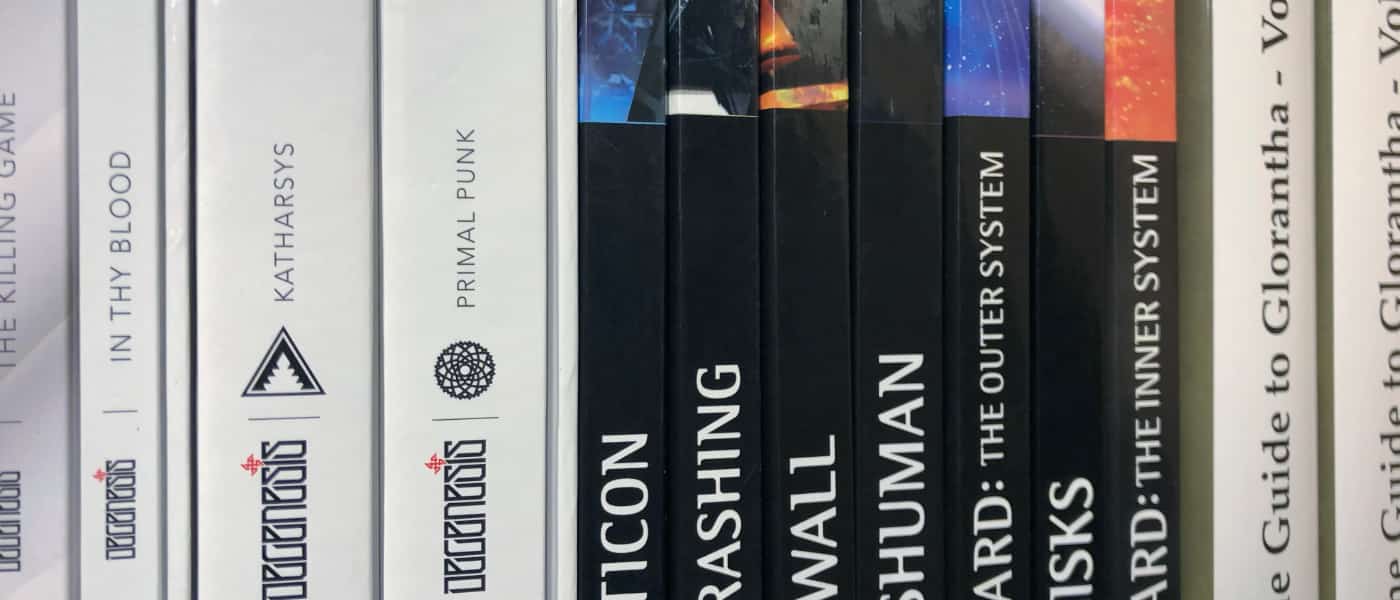
Lesson 1: Set the Stage
Finding a setting you can really sink your teeth into, that you’ll enjoy running for a long time, and that your players will dive into with relish requires some thought. First, it has to satisfy your needs. You’ll be living in the world far more than your players will. You’ll be delving into its inner workings, coming up with adventure hooks, and keeping the world in motion. So make sure the setting is one you’ll want to inhabit for a long time.
The flip side of this coin is that the players have to enjoy it as well. Use their preferences a guidepost. If you are new to the group, before you reveal your exciting campaign to them, make sure to find out what sorts of genre and setting combinations they can’t abide. In my experience finding out which settings are off-limits to your players is more valuable than trying to suss out which settings they will find intriguing. For example, no amount of persuasion will get me interested in a modern-age superheroes campaign or anything Victorian Era. But even though I’m not a huge fan of the western genre, an interesting western setting might entice me.
When you find a complex published setting that looks like it’ll keep your interest for a long time and looks likely to draw in your players, but before you’ve spent any time prepping a campaign, check in with your players. Run through what the setting is about, what kinds of characters they can play, what sorts of adventures can be had, and what themes you’re thinking of exploring. Keep it loose, and listen to their responses. People sometimes talk about this discussion as the “elevator pitch,” but you’re not trying to sell them shares in a startup. You’re trying to gauge their interest and make sure they’re genuinely interested in the setting. If you start things off by trying to cajole them into playing, you’re starting on the wrong foot.
It almost goes without saying, but everyone has to be on board with the game system as well. Most settings are associated with a particular system. But some settings explicitly support multiple systems. Glorantha, for example, is officially supported by three games: RuneQuest, HeroQuest, and 13th Age. And you can always swap in a game system of your choice for whatever setting you choose. It’ll just take more effort. Regardless of the path you take, be sure your players are heading in the same direction before you start walking down it.
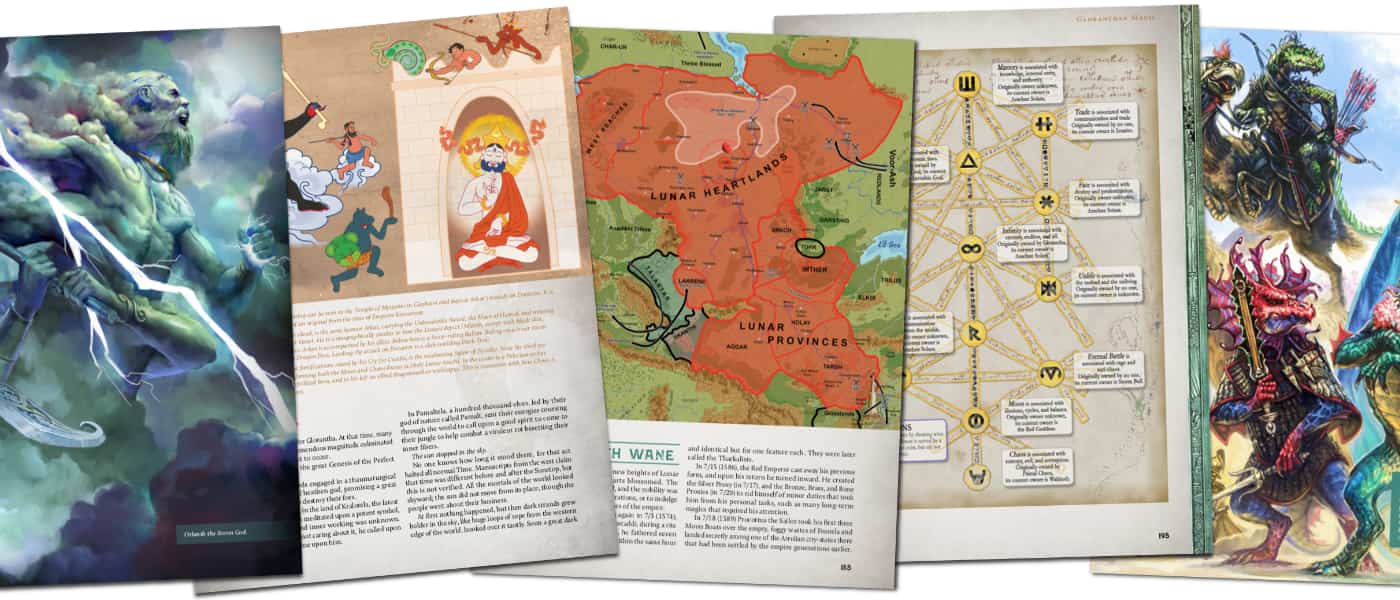
Once you’ve confirmed that the group is excited about the combination of mechanics and setting, it’s time to dive deep into the setting. To run an extended campaign in a complex setting will require your time and energy. Much of that effort will come up front before play starts, and in the early stages of the campaign. With that in mind it pays to think of the setting as something to enjoy for its own sake. Marinade in it. Take notes. Roll ideas around in your head for a while. Don’t rush starting the campaign; get it rolling when you feel ready.
After reading through the setting material and getting comfortable with the major pieces at a high level and how they fit together — the geography, the history, the factions, the threats — think about where you want to start the action. This can be a difficult decision if the setting is full of interesting places. But you can make it easier on yourself if you use a portion of the game world that has already been well-defined. Later you can add details of your own to areas that aren’t covered exhaustively in the setting text, but for now that’s a distraction that will keep your campaign from getting off the ground.
Based on where you want to start the action, think about what kind of PCs would fit. Don’t be afraid to constrain player choices in this regard. For example, when a player wants to run a character that is a member of a faction antithetical to the rest of the group, you have to put in extra effort to make it work somehow. That’s extra effort you don’t need, it’ll make settling into the game world more difficult for the other players, and the setting should provide enough interesting options without the necessity of a twist. This may sound draconian, but for your first campaign in a new setting enforcing constraints will make things smoother for everyone.
Conduct a thorough Session Zero. With a complex setting this is even more important than usual. Have players make their characters together and have those characters originate from within a reasonably manageable geographic area that still allows for diversity of characters. This isn’t a firm requirement, but as with faction constraints it’ll make your life easier. And it’s perfectly reasonable for you as GM to tell them, “Hey, I get that you want to play an evil cyborg unicorn from the most distant corner of the game world, but because we’re all just starting in this setting it’d be a lot easier if you played a character that’s better aligned with the rest of the group.”
No Apocalyptics in Our House
Several months ago I started a Degenesis campaign. Because the world is full of interesting regions and factions, I had a tough time narrowing down the geographic and factional scope for the player characters. Ultimately I determined that I wanted the PCs to have grown up in Lucatore, the town that serves as the focal point for the first published Degenesis adventure, In Thy Blood. With that in mind I narrowed the range of acceptable factions down to four cults: Hellvetics, Judges, Spitalians, and Scrappers.
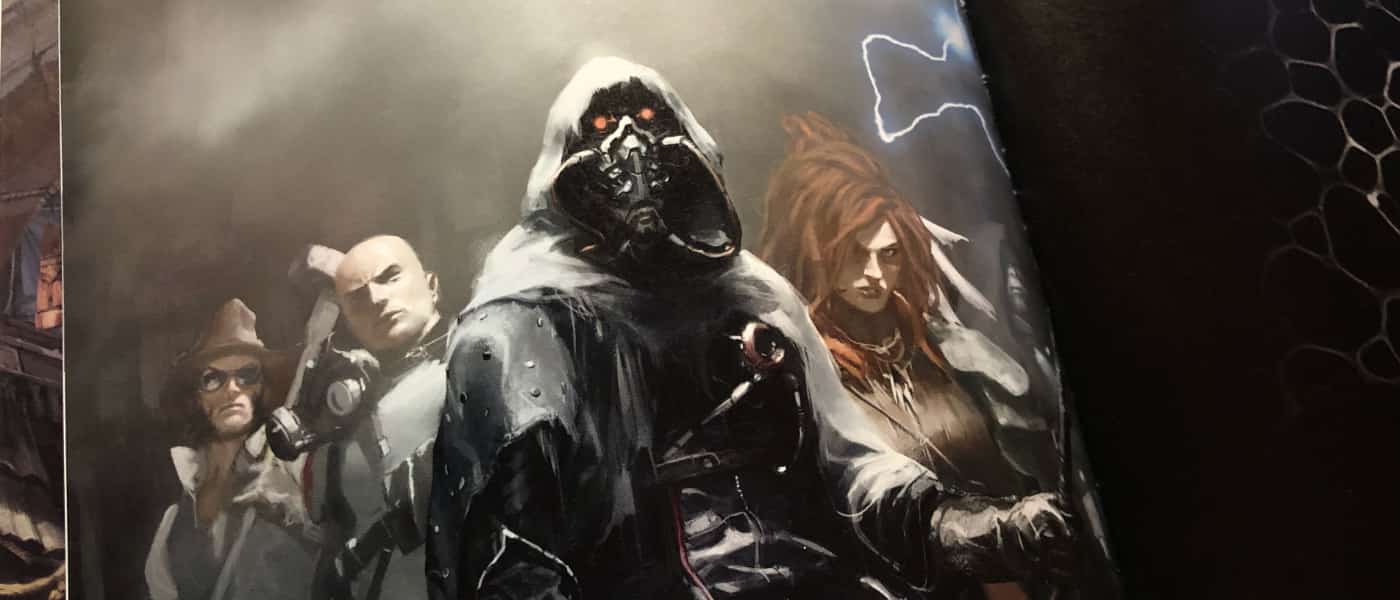
There are several other cults and many clans available in Degenesis, but I wanted to avoid cults that are frequently at odds with each other. There were also a couple of cults I wanted to exclude for reasons having to do with the initial scenario and ideas I had for further exploration. During Session Zero the players each picked a member of a different cult and we collaborated on how they knew each other before each left Lucatore to join a cult.
That initial tie to a home, with relatives, rivals, mentors, and authority figures provided a solid foundation for the campaign. When I ran In Thy Blood the player characters already had bonds with each other and with several of the NPCs in the adventure, as well as family member NPCs we’d worked together to create. It gave added stakes to the events in the adventure and gave me time to slowly introduce more details about their home, the factions they were familiar with, and some of the ripple effects from the broader game world.
Lesson 2: Show (Slowly), Don’t Tell
I had to be hit on the head a couple of times to learn this lesson, so it’s etched deep in my mind: Resist the urge to show the players everything in the game world all at once.
Have the players learn as their characters learn. Don’t get frustrated when your players don’t read the big section of the game book that runs through the last 550 years of setting history in exhaustive detail. Just create a short summary tailored to where they live and what they know. Keep it short — a page or two at most.
During game play introduce character knowledge in context. For example when the PCs journey to a nearby town/spaceport/etc, you can tell the players, “The big gray-clad guards are known as The Gray Guard. From what you’ve heard, they’re all ex-convicts who have been turned into this super-disciplined force that is fanatically devoted to the Prime Leader.” Revealing information along the way like this attaches information to events and makes it easier for players to absorb the game world because it’s always relevant.
Don’t leave home right away. Set the first adventure in and around the locale you’ve established for the PCs. There will be plenty of time for them to get out and explore the world, but you have to give them a firm grounding first. This establishes cultural norms and allows the players to gain a solid understanding of their characters’ place in the world. Later, when they go off into the broader world the contrasts they discover will have more impact. Otherwise it’s just a whirlwind of unrelenting novelty.
Come to Mars! Now Venus! Now the Outer Rim! Now…
The Eclipse Phase setting is mind-bendingly awesome. People can back up their minds and re-sleeve into manufactured bodies. Uplifted animals fight for their rights. Transhumanity has been forced off Earth and is strung across the solar system, organizing in groups large and small under a wide array of political and economic arrangements. Pandora Gates can be used to jump to faraway planets. It’s wild and wooly and tremendous.
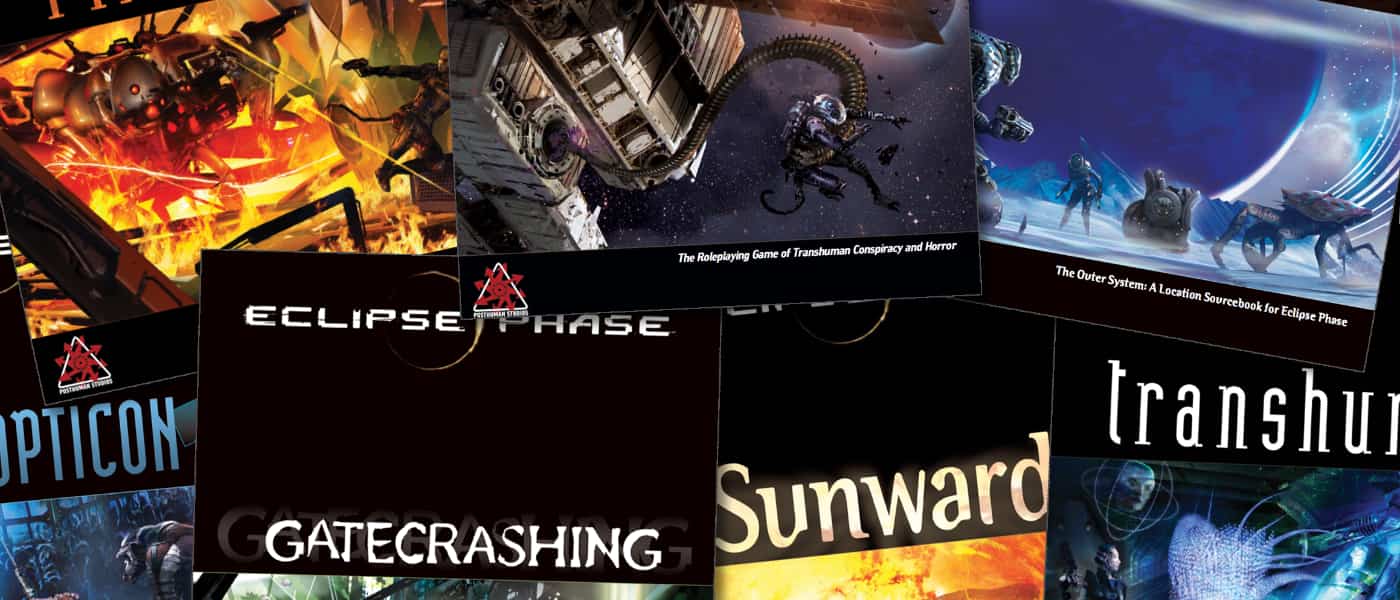
For my first Eclipse Phase campaign I was unable to resist the urge to send the player characters on a whirlwind tour of the solar system. They went from Mars to Venus to the Keiuper Belt. There was plenty of action, but I had to do a lot of prep for each session, and I wound up force-feeding the players information about each new locale they encountered. It got to be a bit overwhelming for them and for me.
I learned my lesson. In the Degenesis campaign even after In Thy Blood the PCs stayed near their home town. They faced plenty of mystery, peril and action; there was no need for me to immediately send them off to an entirely new locale to make that happen. They’ve since ventured out further and have met important NPCs, interacted with other cults, faced new dangers, and pursued goals that flowed from their initial adventures. But because the pace is more deliberate, my prep isn’t as harried and the players have time to absorb the new.
Lesson 3: Mess with the Metaplot
Sprawling, complex published settings often come with a metaplot — a sweeping narrative of what’s happening in the game world. Threats arise, factions score wins and suffer losses, major NPCs affect the flow of world-changing events. The metaplot is the backdrop to the story of your player characters and their adventures. Sometimes PCs interact directly with the metaplot in published adventures, and sometimes the events of the metaplot are simply background — one empire is attacking another, the jostling for influence between two cults becomes open warfare, a gatecrashing expedition has gone horribly wrong.
If you’re using published metaplot materials, it can be tempting to let them straightjacket you as a game master, particularly if the metaplot is full of juicy intrigue and enticing plots. Be strong! You are the game master, and this is your world.
The danger of letting the metaplot dictate your actions as a GM is that it will in turn rob the players of agency. If they don’t feel they can influence the flow of events in the game world, they’re effectively just witnesses rather than real protagonists. No matter how wonderful the setting, no matter how entrancing to you as the GM, it’s there for the players. It needs to engage them and make them want to explore it further. And they need to know their actions in that world will have an impact.
They also want real choices. Railroading gets talked about often in tabletop RPG circles because it’s a real danger for GMs. If players feel like they have no choices, or those choices all lead to the same outcome, they’re riding on railroad tracks; they can’t deviate from the route the GM has laid down for them.

As I’ve noted earlier, it’s perfectly acceptable to limit the choices players can make; constraints are necessary to drive any story forward. The trick is where and how you apply those constraints. The further you get into the details of metaplot, the more latitude you should employ; the primary value of metaplot to you as the GM is to provide shape to ongoing events in the game world.
If the metaplot states that the two primary political powers go to war, that’s important — that’s a foundational element of the metaplot. But when and how the war starts is less important. If a published adventure calls for the death of Duke Rauchenberg but the player characters are about to heroically save the Duke, you likely have plenty of means at your disposal to keep the main thrust of the metaplot intact. Trust your future self to adapt what happens at your table to the metaplot, and to adjust it based on the actions of the player characters. Over time it’ll become your own version of the metaplot, adhering in some respects and deviating in others. And it’ll be awesome.
Your Lucatore Ain’t My Lucatore
To use my current campaign as an example again, the published adventures and metaplot are intertwined in meticulous detail in Degenesis. There is a story, a flow of events that unfolds with exacting specificity. But as a GM I’m free to bend it to my will and to let player actions influence the metaplot
At the conclusion of the In Thy Blood adventure, the situation in and around Lucatore in our campaign differs from what the metaplot defines. The broad arc remains unchanged, but the political situation in Northern Purgare and the state of several key NPCs is unique to our campaign. This is as it should be — player character actions have consequences, and it’s a fun exercise for me to adjust the metaplot accordingly.
Lesson 4: Stay Organized
In real life I’m a product manager. So organizing information is what I do day in and day out. I’ve tried a wide variety of tools and techniques for keeping track of ideas, plans, and outcomes. For the past couple of years at work I’ve used pencil, notebook, and Trello with good results. The same approach (using the free version of the app) has served me well as a GM.
Trello serves as the repository of long-term information. A player-facing board stores Session Zero notes, background info on each of the player characters (added by the players), and any additional information the players want to add. Most importantly, it also holds session summaries. After each session I gather my notes and distill them into a narrative of the events of that session. This is the canonical reference for the campaign. The players find it very helpful, particularly if some time has elapsed between sessions. It’s also invaluable to me as I plan upcoming sessions because I can easily pull from events that occurred several sessions ago.
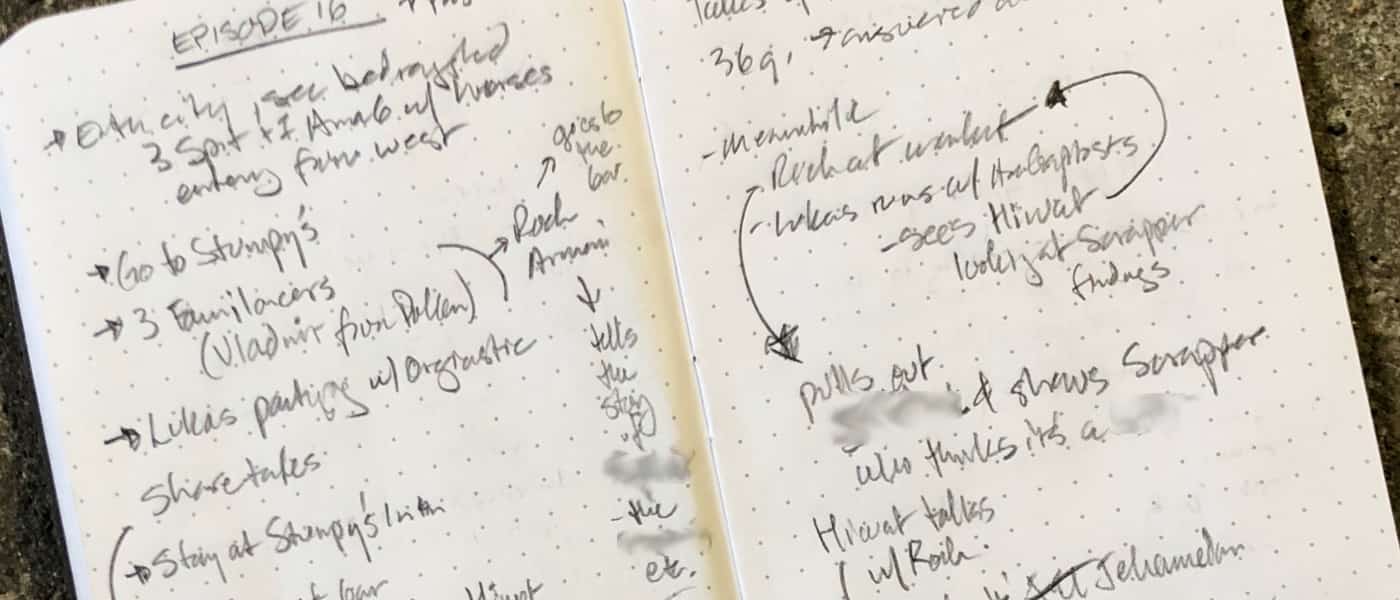
Prior to the start of a session I use a paper notebook to jot down a few bullets about places, NPCs, and events the player characters might encounter during the session. This is informed by the question I always ask players at the end of every game night: “What are you going to do next?” This is vitally important, because while I always want to be flexible as a GM and ready to adapt to player actions, knowing the players’ near-term plans helps focus my session prep.
Once the session starts, I have a GM-only Trello board up on my iPad. This is where detailed notes live — everything from NPC descriptions to maps to random notes about things I might want to throw at the PCs when the time is right. This is just for quick reference as needed.
I use the notebook to take brief notes on what happens each session. It’s just enough to jog my memory and help me recall important moments. When I get home from the session (if I’ve still got the energy) or the next day, I take the brief session notes from my notebook and turn them into a more detailed story of of what occurred. That becomes the session summary in Trello.
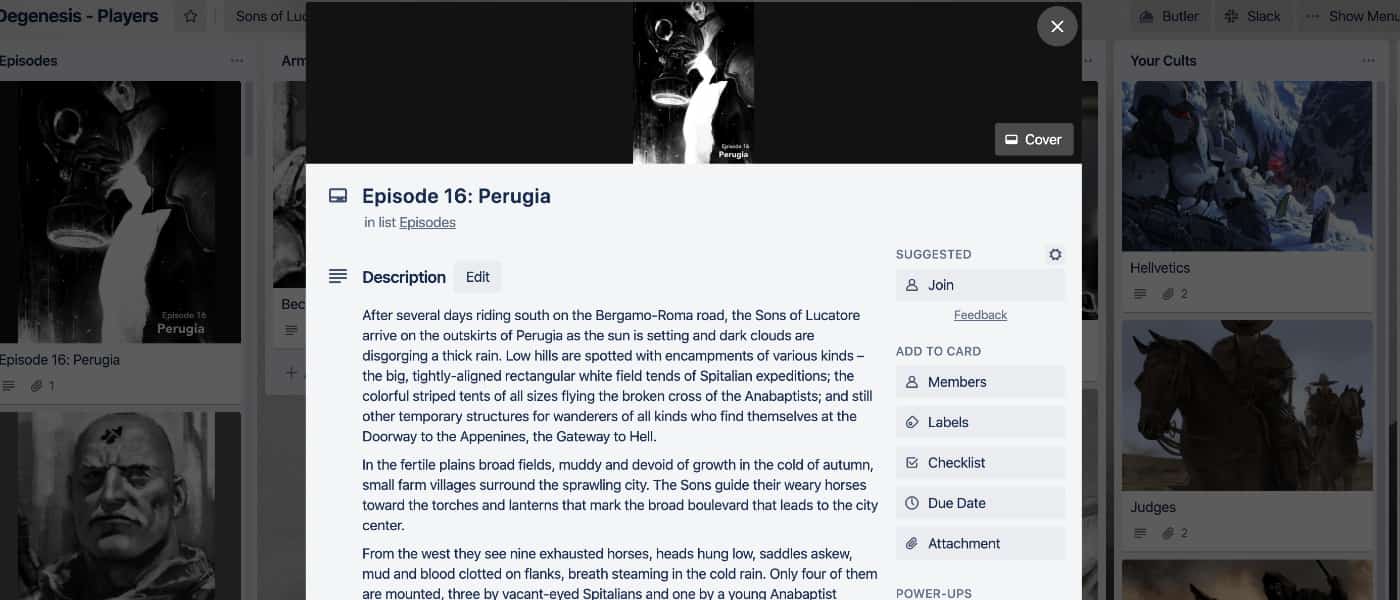
None of this has to be complicated. If you find yourself spending a lot of time with bookkeeping, ask yourself if the tools you’re using are serving you or if you’re serving them. You really just need enough to run each session smoothly and track the story of the campaign.
Lesson 5: Don’t Get Ahead of Yourself
You are not here to write stories. You’re here to set up challenging, intriguing situations for your players. They are the stars. You’re not writing an adventure; you’re keeping the world in motion and introducing challenges for the player characters to face. It’s a lot more fun to be as surprised by the outcome as your players. It also makes your role as a GM more interesting, because instead of trying to steer the players along a predefined path, you get to react in the moment.
Know what your NPCs and other adversaries want up front, and think about how they’d react to what’s going on around them. Know what’s going on in the world. Think about what the player characters have done so far, and how you can follow up on those events to draw them deeper into the larger world. Don’t get lured by the siren song of predefined outcomes.
But You Weren’t Supposed to Kill the Big Bad That Easily!
Years ago I ran an epic RuneQuest session over two days and nights. A friend had access to a room at his college that was perfect for the event — it had whiteboards on all the walls and a huge table that easily fit me and the seven or eight players attending. I’d spent weeks crafting a massive Thanatari cave network stuffed with Chaos creatures, dangerous flora, and other challenges. All the cave paths led eventually to a huge chamber where the Big Bad Thanatar Rune Priest was about to do Bad Things.
I’d envisioned a tremendous fight, with the player characters having to deploy all their magic and skill to defeat the Rune Priest and his minions. But I think you know where this story is going. Yep, sure enough, the players thoroughly reconnoitered the area, sent the stealthiest PC in, and had him shoot the Rune Priest with a magically-juiced arrow.
Head shot. Critical. Ignoring armor. Max damage. One shot, one kill, one dead Big Bad.
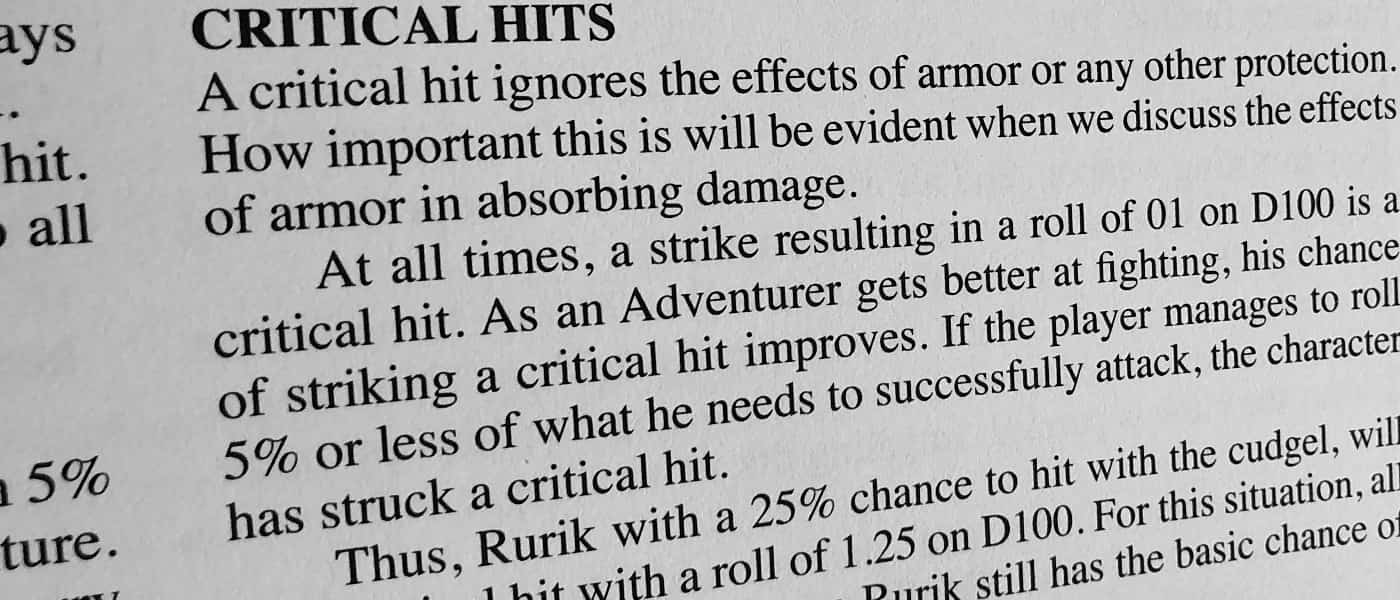
Sure, the odds were low that this critical to the head would occur, but my prep was still too rigid.
It was a fantastic victory for the players, and I applauded their clever approach, not to mention astounding luck. But my prep had all been oriented toward a specific outcome that didn’t transpire. So I felt cheated. I had put all this preparation into what I hoped would culminate in an epic battle!
I wound up re-using the stats for the Rune Priest later when the player characters reached the surface, having thoroughly exterminated the Thanatari and nearly everything else in the cave network. I had this “second” Rune Priest show up with several acolytes, under the pretense that he was returning from some above-ground mission.
The PCs wound up taking down the replacement Rune Priest after a vicious fight, but I thought about it later and realized that had any of the PCs died in that combat, it would have been because I got too attached to my own vision of how the session was supposed to play out. This kind of attachment is dangerous; it often leads to players recognizing that events are being arbitrarily manipulated. Action in the game world is always dynamic; you as the GM have to control everything that happens around the player characters. But if that action becomes detached from internal logic you’ve already established, players will notice they’re being led to a predetermined destination and will feel railroaded.
Lesson 6: (Don’t) Mind the Gaps
If you’re like me you’ll never feel like you’re doing a good enough job of conveying the marvelous intricacies of the game world to your players. They won’t know all the details you’ve absorbed about the social structure of the Aldryami. They won’t know the name of the king who rules the lands to the west, or the history behind the Jovian political system. But that doesn’t matter. Verisimilitude is what you’re going for, and verisimilitude is the feeling of being real, rather than a meticulous accounting of every detail.

Why does it rain in the 2019 Los Angeles of Blade Runner? The movie doesn’t tell us, because we as viewers don’t need to know the reason. We just need to know the effect. Complex worlds are, like our own, multivariate. And just as in the real world, your players will paper over, fill in, or just ignore completely the gaps they encounter in your presentation of the game world. Most of the time they won’t even notice them, because they’ll be too immersed in the story of what is happening to their characters.
Savor the Rewards
Campaigns set in complex published settings take effort as a game master — there’s no getting around that. But if you enjoy diving deep into a game world, the rewards for you and your players can be well worth it.
Ω